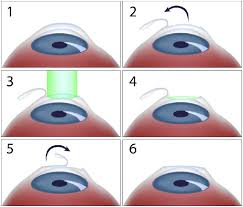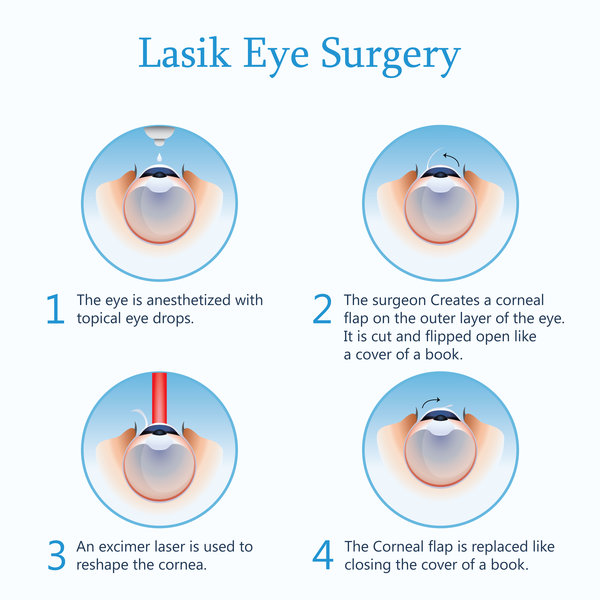Laser refractive surgery

About Laser Refractive Surgery:
It is an effective treatment for correcting myopia, farsightedness, and astigmatism. As a patient one should know that there are minimum requirements to be able to operate.
It is important that the graduation be stable during the last year for the treatment to be effective in the long term. Otherwise, if after surgery your cornea evolves you will need a second operation or you may have to wear glasses or contact lenses.
Who are eligible for Laser Refractive Surgery?
The suggested minimum age to operate would be 18 years in patients with less than 3 diopters of myopia.
There are patients under 21 years of age who have eyesight to meet the visual requirements for being a police officer or firefighter. Preoperative testing will be critical. They will determine if the patient is eligible for Laser Refractive Surgery and if we can operate safely.
In principle there is no maximum age for Laser Refractive Surgery. In fact, many cataract surgery patients are also laser-corrected to get the best vision possible.
However,for patients over the age of 36, it must be clear that within a few years they will begin to notice the tired sight. Laser refractive surgery for myopia, farsightedness or astigmatism does not prevent this problem. In fact, you probably may need glasses to see up close or have to resort to a presbyopia operation.
LASIK

IS LASIK FOR YOU?
LASIK is a laser procedure, used to correct Myopia (Short-sightedness), Hyperopia (Long-sightedness) and Astigmatism, to reduce or eliminate a person's dependence on spectacles and contact lenses. Spectacles could impede those who lead an active lifestyle, especially in sports and games. As an alternative, this same group of people would look to contact lenses for clear vision.
Although contact lenses provide good vision to many people, it has its constraints such as dry eyes and eye allergy. When worn over a prolonged period, it can cause damage to the surface of the eyes due to the lack of oxygen. Furthermore, it can lead to infection of the cornea. In light of these constraints, LASIK is the solution.
To be a good candidate for LASIK, you should:
- Have a stable spectacle power for at least one year
- Not have eye diseases such as keratoconus
(weak protruding cornea) - Have a suitable range of myopia and/or astigmatism
- Not be pregnant
PROCEDURES AVAILABLE:
LASIK
The term LASIK is utilized when the technique includes making a corneal flap.
Conventionally, a cutting-edge instrument called Microkeratome is utilized to make the cornea fold. The flap made is then collapsed aside, to empower the Excimer laser to carry out the activity of reshaping the cornea. The cornea fold is then returned to its unique origin position.
IntraLase Method
The Microkeratome strategy has gradually been eliminated throughout the years. Nowadays, specialists will make utilization of the sharp edge free technique to make the cornea fold. We have been utilizing this technique since 2008. Some have likewise called this the All-Laser LASIK. This is a costly laser machine which utilizes a propelled femtosecond laser technology to accomplish a more precise, and more secure flap-making process.
Since the IntraLase is enabled by PC control accuracy, it enables the specialist to redo the profundity, width, shape, and area in making a thin cornea fold with a specific end goal to tweak to the requirements of the individual patient.
The IntraLase laser makes air rises in the stroma of the cornea. Air bubbles make space and the fold isn't lifted until the point when the LASIK specialist utilizes an uncommon surgical instrument to lift the cornea fold. This implies the cornea is as yet in place after the IntraLase laser and the patient can flicker regularly and stroll around typically without expecting that the fold will unstick.
There are a few generations of the Intralase being used in India. This is the most recent adaptation of the Intralase. This rendition lasers 2.5 times speedier than the past age (FS60), so it sets aside a significantly shorter opportunity to finish the methodology. The cornea fold is likewise more steady and there is less irritation as less vitality is utilized.
Epi-LASIK / PRK / LASEK / No-touch Epi-LASIK
Aside from the above strategies in which a cornea fold is made, Epi-LASIK is a technique that does not make any cornea fold. A particular hardware is utilized to isolate a thin layer of cells known as epithelium on the front surface of the cornea. The laser is connected and the thin layer of cells is then put back finished the cornea.
Another approach to perform the surgery without the requirement for a cornea fold is to perform PRK (Photorefractive Keratectomy), this technique includes scratching off the epithelium. A variety of this strategy includes applying some liquor over the cornea for a brief timeframe to make it simpler for the cells to be expelled, this technique is known as LASIK.
The preferred procedure to do the no-flap technique is to use an even more advanced method: No-touch Epi-LASIK. This method utilizes the advanced Amaris laser to remove the epithelium. This means that there is no need to use any equipment to scrape the skin cells away, the laser does the entire procedure. This reduces surgery time and increases precision. There have been quite a few terms for this particular method of surgery, some call it Bladeless Epi-LASIK or Trans-PRK or Trans Epi-LASIK. The simple way to think of it is No Touch and No Flap.
Not everyone is suitable for this technique. It is important for you to go through an assessment of your eyes and our doctor will determine which method best suits your eyes.
There are a few focuses on the planet that utilization Relex Smile. This is a less develop innovation than LASIK. Not at all like LASIK or Epi-LASIK, it can't treat individuals with low measures of childishness and the method is impossible once more (improvement) on a similar eye if necessary. This technique isn't genuinely flapless as it includes disturbing the layers of the cornea with the end goal that a little layer of the cornea can be evacuated through an opening in favor of the cornea.
SIDE EFFECTS OF LASIK
As like in all surgical procedures, there are some side effects that may occur undergoing LASIK surgery. Although this surgery is very accurate, perfect vision cannot be guaranteed. Most of the problems after surgery are temporary and do not affect vision.
Some of the side effects are:
-
Dry eyes
Dry eyes after laser vision correction is common. This is easily treated with eye drops. This condition does not usually affect vision and will subside within 1 to 2 months.
-
Night Vision Problems
For those who observe this effect - it occurs in the early stages after treatment but will gradually diminish over the course of 3 to 4 months. Pupil size in dim light is measured before the surgery and you will be advised if you are at risk of observing this effect after surgery.
-
Under and Over-corrections
This is uncommon, usually in the range of 1 to 3%. For example, a person with 900 degrees of Myopia may be left with 50 degrees in a case of under-correction. If it does occur a top-up laser can be performed at 3 months after the first laser treatment.
-
Infection
Infections due to surgery is a rarity, compared to infections caused by contact lens wear. (Antibiotics are given during and after surgery to prevent such occurrence)